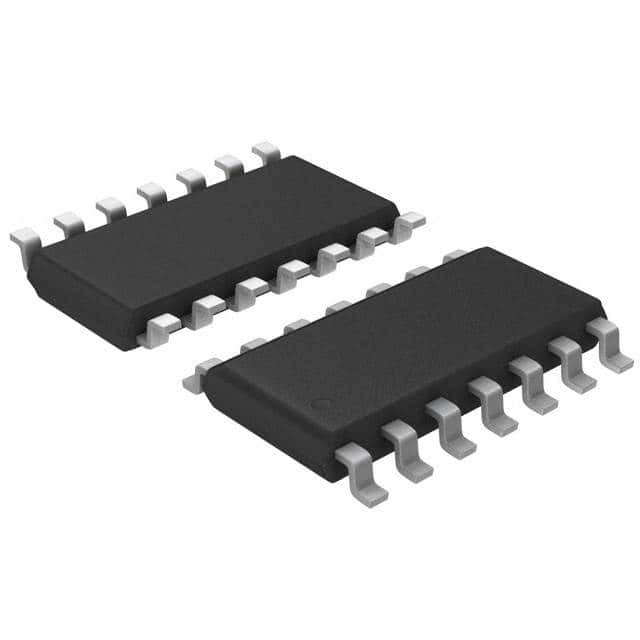Xem thông số kỹ thuật để biết chi tiết sản phẩm.

Encyclopedia Entry: 74VHC04M
Product Overview
Category
The 74VHC04M belongs to the category of integrated circuits (ICs) and specifically falls under the family of logic gates.
Use
This product is commonly used in digital electronics for signal processing and logical operations. It serves as an inverter, converting input signals into their complementary form.
Characteristics
- High-speed operation: The 74VHC04M is designed to operate at high speeds, making it suitable for applications that require quick response times.
- Low power consumption: This IC is known for its low power consumption, making it energy-efficient.
- Wide voltage range: It can operate within a wide voltage range, typically between 2V and 5.5V.
- Compatibility: The 74VHC04M is compatible with both TTL (Transistor-Transistor Logic) and CMOS (Complementary Metal-Oxide-Semiconductor) logic families.
Package and Quantity
The 74VHC04M is available in a small outline integrated circuit (SOIC) package. It is commonly sold in reels or tubes containing multiple units, with quantities varying depending on the supplier.
Specifications
- Supply Voltage Range: 2V to 5.5V
- Input Voltage Range: 0V to VCC
- Output Voltage Range: 0V to VCC
- Operating Temperature Range: -40°C to +85°C
- Maximum Propagation Delay: 6 ns
- Maximum Quiescent Current: 1 μA
Pin Configuration
The 74VHC04M has a total of 14 pins, each serving a specific function. The pin configuration is as follows:
__ __
|1 \/ 14|
--|2 13|--
--|3 12|--
--|4 11|--
--|5 M 10|--
--|6 C 9|--
--|7 0 8|--
|_________|
Functional Features
- Inverting Function: The 74VHC04M performs the logical inversion of input signals, producing their complementary outputs.
- High-Speed Operation: This IC is designed to operate at high speeds, enabling rapid signal processing.
- Wide Voltage Range Compatibility: It can work with various voltage levels, making it versatile for different applications.
- Low Power Consumption: The 74VHC04M consumes minimal power, contributing to energy efficiency.
Advantages and Disadvantages
Advantages
- High-speed operation allows for quick response times in digital circuits.
- Low power consumption contributes to energy efficiency.
- Wide voltage range compatibility makes it suitable for diverse applications.
- Compact SOIC package enables easy integration into circuit designs.
Disadvantages
- Limited number of logic gates per IC compared to larger-scale integrated circuits.
- May require additional components for complex logic operations.
Working Principles
The 74VHC04M operates based on the principles of complementary metal-oxide-semiconductor (CMOS) technology. It utilizes a combination of p-type and n-type metal-oxide-semiconductor field-effect transistors (MOSFETs) to achieve logical inversion. When an input signal is applied, the internal circuitry of the IC processes it and produces the complementary output.
Application Field Plans
The 74VHC04M finds application in various fields, including: 1. Digital communication systems 2. Microcontrollers and microprocessors 3. Industrial automation 4. Consumer electronics 5. Automotive electronics
Alternative Models
Several alternative models are available that offer similar functionality to the 74VHC04M. Some notable alternatives include: - 74HC04: A compatible IC from the HC family, offering similar characteristics and pin configuration. - CD4069: A CMOS-based hex inverter IC with comparable specifications. - SN74LS04: A TTL-based hex inverter IC that can be used as an alternative.
These alternatives can be considered based on specific project requirements and availability.
In conclusion, the 74VHC04M is a high-speed, low-power logic gate IC commonly used for signal processing and logical operations. Its wide voltage range compatibility and compact package make it suitable for various applications in digital electronics. While it has advantages such as quick response times and energy efficiency, it also has limitations regarding the number of logic gates per IC. Understanding its working principles and considering alternative models can aid in selecting the appropriate IC for specific projects.
Liệt kê 10 câu hỏi và câu trả lời thường gặp liên quan đến ứng dụng 74VHC04M trong giải pháp kỹ thuật
Sure! Here are 10 common questions and answers related to the application of 74VHC04M in technical solutions:
Q: What is the 74VHC04M? A: The 74VHC04M is a hex inverter IC (Integrated Circuit) that consists of six independent inverters.
Q: What is the voltage supply range for the 74VHC04M? A: The 74VHC04M operates with a voltage supply range of 2.0V to 5.5V.
Q: What is the maximum output current of the 74VHC04M? A: The maximum output current of the 74VHC04M is typically 8mA.
Q: Can the 74VHC04M be used as a level shifter? A: Yes, the 74VHC04M can be used as a level shifter to convert signals between different voltage levels.
Q: How can I connect multiple 74VHC04M ICs together? A: You can connect multiple 74VHC04M ICs by connecting their inputs and outputs in parallel.
Q: What is the propagation delay of the 74VHC04M? A: The propagation delay of the 74VHC04M is typically around 7ns.
Q: Can the 74VHC04M drive capacitive loads? A: Yes, the 74VHC04M can drive capacitive loads up to a certain limit. It is recommended to refer to the datasheet for specific details.
Q: Is the 74VHC04M suitable for high-speed applications? A: Yes, the 74VHC04M is designed for high-speed operation and can be used in various high-speed applications.
Q: Can the 74VHC04M tolerate overvoltage conditions? A: The 74VHC04M has built-in protection against overvoltage conditions, but it is still recommended to operate within the specified voltage range.
Q: What are some common applications of the 74VHC04M? A: The 74VHC04M is commonly used in digital logic circuits, signal inversion, clock generation, waveform shaping, and many other applications where signal inversion or buffering is required.
Please note that these answers are general and may vary depending on specific use cases and requirements. It is always recommended to refer to the datasheet and consult with technical experts for accurate information.

